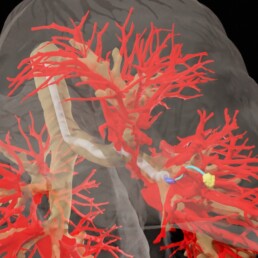Researchers Demonstrate the First Autonomous Medical Robot That Steers Needles In Vivo
To safely operate, an autonomous vehicle needs to be able to recognize and avoid obstacles in real time. Even a momentary lapse could lead to disastrous consequences, especially if the vehicle is a medical needle, less than a millimeter wide, navigating through the cluttered tissue of a patient’s lungs en route to a cancerous nodule.
Safely and accurately reaching a site inside living tissue is currently often challenging for physicians, especially inside complex, moving anatomy like the lung. Errors can be fatal: the failure to precisely reach a suspicious nodule in the lung can result in an inaccurate diagnosis and hence allow cancer to spread untreated. An autonomous robot has the potential to exceed the accuracy that a human operator can safely accomplish using currently available tools.
A team of researchers from the University of Utah’s John and Marcia Price College of Engineering, University of North Carolina at Chapel Hill, and Vanderbilt University have demonstrated, for the first time, a robotic needle capable of autonomously maneuvering around obstacles to a target in living tissue.


